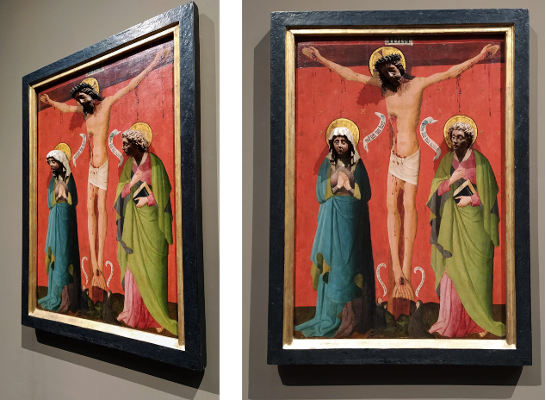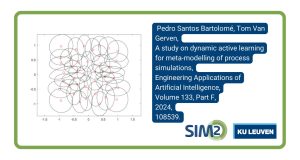Multimedia since the Middle Ages
What do you think when you hear about art from the Middle Ages? Probably you would imagine large paintings sitting at churches decorating the chapels trying to attract the gaze of pious visitors or even place yourself in medieval patios with sculptures of saints and bishops. This was also my thought until I visited the Wallraf-Richartz Museum1 in Cologne where something caught my eye. There was a piece of art with something sticking out, what was it? It was the face of the saints coming at me as if the figures were coming alive. I immediately read the description which talked about the painting and its purpose.

Figure 1. “Christ on the Cross between Mary and John”, around 1425-1435, collection Ferdinand Franz Wallraf- WRM 57
“This unusual place-part sculpture-may be entirely from a carver. That would explain the quality of the heads and the plasticity of the painted figures. When looked at in passing, the carved heads seem to move back and forth. This also fits the symmetrical arrangement of the banderoles around Christ, who has just commended his mother and his favorite disciple to one another: “Woman, behold thy son, and “John, behold thy mother” (John 19, 25-27). Medieval reports often tell of miracles in which paintings of the Crucified Jesus or the Virgin Mary spoke and made gestures that extended out into the viewer’s own physical world. This “multimedia” work simulates just such a vision”.
Suddenly the word multimedia resonated in my head. Isn’t this something about movies, the TV or the radio? In reality, it can be a broader concept that involves not only the media we associate with the technologies of the 21st century, but it is more about the formats of expression that could include paintings, sculptures, or even gastronomical dishes. Multimedia is about the formats used to convey ideas.
The creators have the task of presenting those ideas and the viewers can react in different ways. They could feel amazed, bored, excited, or even get knowledge out of it. In Charming project, we have a very specific goal. We want to find a new way of making people connect to knowledge and change the paradigm of learning to be fun, but how to do it?
If the creators want to guide the reactions towards learning, then they should answer the question: How can the formats of expression be used to encourage learning? There can be many answers.
Richard Mayer proposed one way2. His cognitive theory of multimedia learning guides the process of the creator and makes some assumptions about how people learn from multimedia. It considers the channels for processing information, the limitation of each channel, and how people filter, select, organize, and integrate the information. One of the main paradigms of this theory is that people learn more from words and pictures than only from words. Furthermore, these assumptions are tied just to visual and auditory formats3. These ideas have been used in the new waves of learning such as the massive open online courses (MOOC) that are a current trend in higher education4.
Nowadays, the educational wave has expanded to the new technologies available that augment the schemes used to convey ideas through interactive experiences, such as VR and AR. Therefore, we need to ask for new things. Which situations these new mediums give an advantage? How do people learn with these mediums? Who learns better from these experiences? And even, how do we mix these experiences with other forms of expression. Like Middle Ages painters and carvers who wanted to show the vision of a miracle, we will keep on thinking how to convey our messages in the sculptures of the 21st century.
References
1. https://www.wallraf.museum/en/collections/ (accessed: 01/08/20)
2. Mayer, R.E. (2009). Multimedia learning (2nd ed.) Cambridge University Press. https://doi.org/10.1017/CBO9780511811678
3. https://ctl.wiley.com/principles-of-multimedia-learning/ (accessed: 01/08/20)
4. Oakley, Barbara A., and Terrence J. Sejnowski. “What We Learned from Creating One of the World’s Most Popular MOOCs.” Npj Science of Learning 4, no. 1 (June 14, 2019): 7. https://doi.org/10.1038/s41539-019-0046-0.






